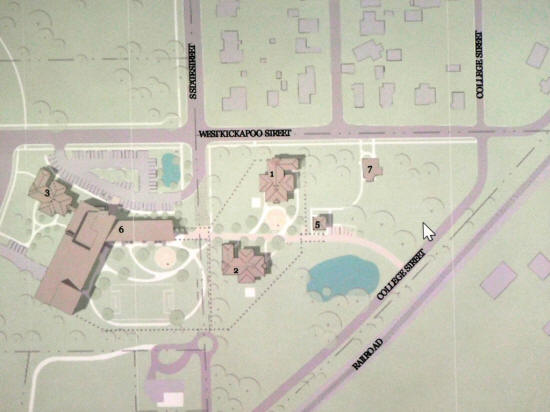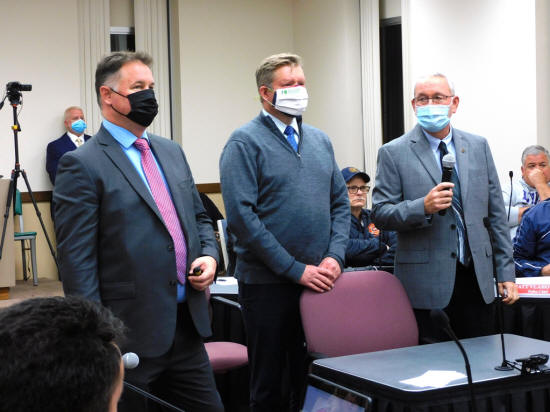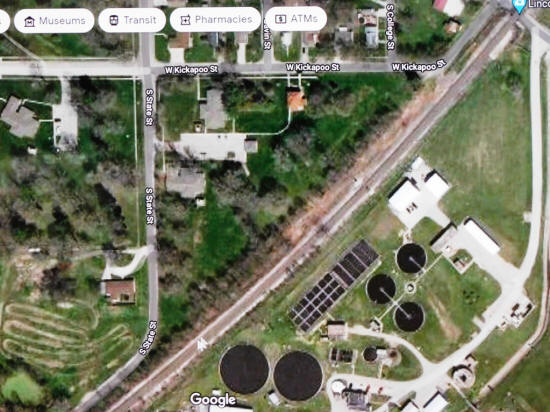|
Lincoln City Council
City hears request to abandon 485 feet of South State Street for
Youth Detention Center
 Send a link to a friend
Send a link to a friend
 [November 13, 2021] [November 13, 2021]
At the Tuesday night committee of the whole meeting of the Lincoln
City Council representatives of the Illinois Department of Juvenile
Justice presented a request to permanently close 485 feet of South
State Street. The section runs through the proposed new campus for
Juvenile detention center on the east side of the former Lincoln
Developmental Center.

The outline presented by the representative’s show that the campus
for the detention center is made up of two segments. The first is an
oblong section that runs north and south on the west side of State
Street. The second segment is a triangular shaped parcel that runs
on the east side of State Street. The two parcels join on the south
end of the oblong.

The DJJ is requesting that the portion of State Street that lies
between the two adjoining parcel be permanently closed and a new
street be built on the far east end of the triangle and running
south west to reconnect with State once again.

Addressing the council were Tim Weber with Cordogan Clark &
Associates, Dustin Erikson of Terra Engineering and Bill Peyton of
the DJJ.
Peyton opened the discussion with a short review of the plans for
the property. He explained that the facility will offer services to
30 youth in residence. He said that the LDC property was chosen for
multiple reasons, not the least of which is location in central
Illinois. He explained that there are youth detention centers around
the state, but there are none in the central part of the state. The
location would enable the DJJ to house these youth in areas that are
closer to their home communities making it easier for the youth and
their families. In addition he said that Lincoln offers
opportunities for valuable community partnerships such as with the
local colleges for post-secondary education.

Weber said the DJJ is taking only a small portion of the total LDC
Campus. Within the portion it is taking are four cottages, two which
will be used for housing of youth and two that will be used for
administration and counselling services. In addition, the DJJ will
build another building that will be utilized for education and other
services for the youth.
The issue that the DJJ and his firm have been working to address
concerns how to get the youth safely across the street from housing
on the east of State Street and services on the west. He said that
they had considered a number of options, but the one that seemed to
be the best was to close State Street.
Erikson is the engineer for the project and said that the site plan
would do away with 485 feet of State Street. At the same time, he
acknowledged that there are public utilities that run along that
length of street they are asking to be closed. He said the DJJ would
give easements to those utilities so that they would have access as
needed. It was also noted that the Ameren Illinois electric lines
are currently above ground, located on poles. Discussions are
underway about burying those lines that close through the DJJ
campus.
It was also noted that at the far south end of that section of State
Street is a single dwelling home that is not part of the campus. It
was explained that the south end of State would remain intact giving
access to that home.
Alderman Rick Hoefle asked why the group was proposing connecting
the new road to College Street instead of West Kickapoo. From the
maps provided during the presentation, West Kickapoo looked like a
natural connection.
[to top of second column] |

Erickson said that in talking with Lincoln Street Superintendent Walt Landers,
Landers had felt that connecting to College would be the better solution.
Landers addressed the question and said that on West Kickapoo coming out from
the under the viaduct, there is a very steep incline as well as existing
intersections. He felt that College would be safer for motorists as well as
better for police and fire.

Steve Parrot noted that in the aerial view there appears to be a line of trees
about where the new road will go. He asked if the trees would have to be
removed. Erickson said at this point that is unknown. The engineers will have to
examine the property lines and look at the railroad right of ways. Landers said
that there would also be city right of ways and drainage that would have to be
addressed on both sides of the new road. He felt certain there would have to be
some clearing done in that area. Parrott said he was considering the amount of
trash that would have to be cleaned up along the tracks as well. He added that
he wanted the road to look nice including the right of ways.

Wanda Lee Rohlfs asked how the new road would be paid for, was the city expected
to bear that expense? Weber said that DJJ would build the new road, and then
would turn ownership of the road over to the city. The city would then be
responsible for maintenance.
Downs asked if the facility would be fenced and how. Weber said it would be
fenced. The fencing will be ten feet tall and a black mesh. He added that the
fencing will not be close to the road. Parrott wanted to know if the fence would
be topped with razor wire as most adult detention centers are. He was told there
would be no razor wire.
Rohlfs said that prior to returning to the city council, she had taken a “field
trip” tour of the facility in Onarga as a citizen. She noted there are no fences
at Onarga. She asked why will there be fences in Lincoln, what is the difference
between this detention center and Onarga?
Rohlfs also said that she felt it would be beneficial to the newer members of
the council if the DJJ would come back and explain the project from a
“contextual” perspective, what the programs will be at the center, what the
youth will be doing in regard to education, activities and etcetera?
Kevin Bateman asked about the rest of the LDC property and if there were any
plans for further development. Mayor Tracy Welch said that he had spoken with
Senator Sally Turner about this. The DJJ claimed their piece of the property
when the LDC campus was placed on the states surplus list for possible disposal.
Welch said the campus will be coming back on the list soon. He added that the
perfect scenario would be for the state to give the balance of the property to
the city so the city could develop it.
At the end of the conversations, Rohlfs asked what the anticipated occupancy
date for the new facility will be. Peyton said that the goal is occupancy by
August, 2023.
Welch concluded the conversations saying that the ask of the DJJ was for the
council to endorse the plan for the permanent closure of 485 feet of South State
Street and the construction of 1,060 feet of new street to be connected to and
named South College Street. The request was placed on the agenda for the next
voting session on Monday, November 15th.

On the Monday agenda the item will be 11B – “Approval of design for the
construction and re-alignment of State Street and College Street to accommodate
the Department of Juvenile Justice facility.”
As is always the case, the city council has the right to table an item on the
agenda if they feel they need additional time to make a well-informed decision.
[Nila Smith]
Lincoln City Council
Illinois Department of Juvenile Justice explains plans for
new facility at former Lincoln Developmental Center in Lincoln
PRITZKER ADMINISTRATION ANNOUNCES NEW ILLINOIS YOUTH
CENTER IN CENTRAL ILLINOIS
The Illinois Department of Juvenile Justice will renovate former Lincoln
Development Center for its new 21st Century Illinois Transformation Model |